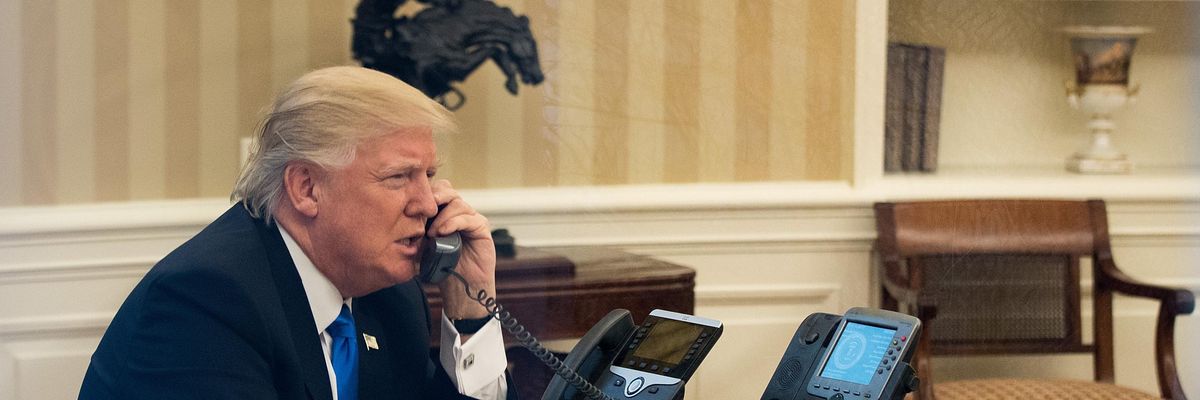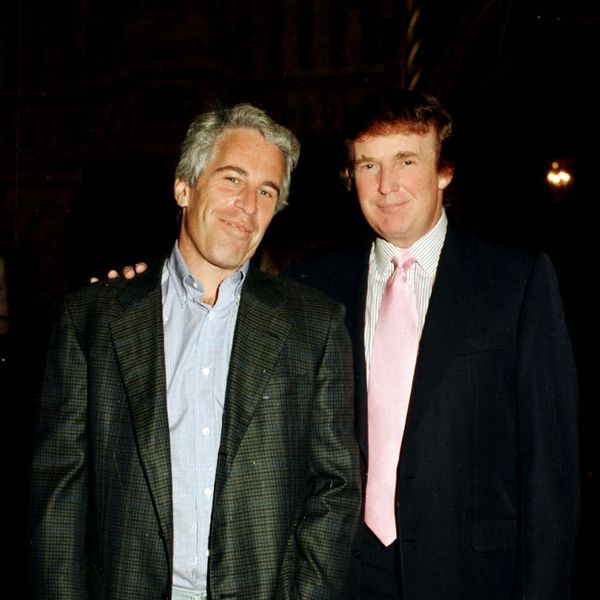
Then-President Donald Trump spoke on the phone in the White House on January 28, 2017. (Photo: Drew Angerer/Getty Images)
'Where Did the Classified Content Go?' Dozens of Empty Folders Seized From Trump Home
"The only thing more concerning than finding classified documents in Donald Trump's possession is finding the folders used to conceal classified documents empty and in Donald Trump's possession."
The U.S. Department of Justice on Friday released an inventory of items seized from former President Donald Trump's Florida home last month, and one aspect of the newly disclosed document raised eyebrows and many questions: Namely, the listing of dozens of empty folders marked as "classified."
"Where did the classified content go?" asked Rep. Ilhan Omar (D-Minn.), voicing a sentiment also expressed by reporters and watchdogs in response to the inventory, which indicates that the FBI retrieved from Mar-a-Lago 18 documents marked "top secret," 54 marked "secret," and 48 empty folders with "classified" banners.
The document, which was ordered unsealed by a federal judge, also lists dozens of additional empty folders labeled as "return to staff secretary/military aide."
The inventory offers no specific details on what the empty folders were supposed to contain, leaving observers to speculate on the sensitivity of the documents and where they may have ended up as the DOJ continues to investigate the former president's removal of classified documents from the White House.
"The only thing more concerning than finding classified documents in Donald Trump's possession is finding the folders used to conceal classified documents empty and in Donald Trump's possession," tweeted Rep. Gerry Connolly (D-Va.). "This information must be accounted for--all of it."
The Associated Press noted Friday that "the Justice Department has said there was no secure space at Mar-a-Lago for sensitive government secrets, and has opened a criminal investigation focused on their retention there and on what it says were efforts in the last several months to obstruct that probe."
Earlier this week, the DOJ released a photo of classified documents that federal agents seized from Trump's home during an August 8 raid. Previous reporting has indicated that classified nuclear weapons documents were among the files FBI officials were trying to recover in the Mar-a-Lago raid.
The Justice Department said in a court filing Tuesday that it "developed evidence that government records were likely concealed and removed" from a Mar-a-Lago storage room as investigators attempted to retrieve them, possibly further implicating Trump's team and the former president himself in a criminal scheme to obstruct justice.
In a status report unsealed Friday, the DOJ said that "the seized materials will continue to be used to further the government's investigation, and the investigative team will continue to use and evaluate the seized materials as it takes further investigative steps, such as through additional witness interviews and grand jury practice."
"All evidence pertaining to the seized items--including, but not limited to, the nature and manner in which they were stored as well as any evidence with respect to particular documents or items of interest--will inform the government's investigation," the report reads.
An Urgent Message From Our Co-Founder
Dear Common Dreams reader, The U.S. is on a fast track to authoritarianism like nothing I've ever seen. Meanwhile, corporate news outlets are utterly capitulating to Trump, twisting their coverage to avoid drawing his ire while lining up to stuff cash in his pockets. That's why I believe that Common Dreams is doing the best and most consequential reporting that we've ever done. Our small but mighty team is a progressive reporting powerhouse, covering the news every day that the corporate media never will. Our mission has always been simple: To inform. To inspire. And to ignite change for the common good. Now here's the key piece that I want all our readers to understand: None of this would be possible without your financial support. That's not just some fundraising cliche. It's the absolute and literal truth. We don't accept corporate advertising and never will. We don't have a paywall because we don't think people should be blocked from critical news based on their ability to pay. Everything we do is funded by the donations of readers like you. Will you donate now to help power the nonprofit, independent reporting of Common Dreams? Thank you for being a vital member of our community. Together, we can keep independent journalism alive when it’s needed most. - Craig Brown, Co-founder |
The U.S. Department of Justice on Friday released an inventory of items seized from former President Donald Trump's Florida home last month, and one aspect of the newly disclosed document raised eyebrows and many questions: Namely, the listing of dozens of empty folders marked as "classified."
"Where did the classified content go?" asked Rep. Ilhan Omar (D-Minn.), voicing a sentiment also expressed by reporters and watchdogs in response to the inventory, which indicates that the FBI retrieved from Mar-a-Lago 18 documents marked "top secret," 54 marked "secret," and 48 empty folders with "classified" banners.
The document, which was ordered unsealed by a federal judge, also lists dozens of additional empty folders labeled as "return to staff secretary/military aide."
The inventory offers no specific details on what the empty folders were supposed to contain, leaving observers to speculate on the sensitivity of the documents and where they may have ended up as the DOJ continues to investigate the former president's removal of classified documents from the White House.
"The only thing more concerning than finding classified documents in Donald Trump's possession is finding the folders used to conceal classified documents empty and in Donald Trump's possession," tweeted Rep. Gerry Connolly (D-Va.). "This information must be accounted for--all of it."
The Associated Press noted Friday that "the Justice Department has said there was no secure space at Mar-a-Lago for sensitive government secrets, and has opened a criminal investigation focused on their retention there and on what it says were efforts in the last several months to obstruct that probe."
Earlier this week, the DOJ released a photo of classified documents that federal agents seized from Trump's home during an August 8 raid. Previous reporting has indicated that classified nuclear weapons documents were among the files FBI officials were trying to recover in the Mar-a-Lago raid.
The Justice Department said in a court filing Tuesday that it "developed evidence that government records were likely concealed and removed" from a Mar-a-Lago storage room as investigators attempted to retrieve them, possibly further implicating Trump's team and the former president himself in a criminal scheme to obstruct justice.
In a status report unsealed Friday, the DOJ said that "the seized materials will continue to be used to further the government's investigation, and the investigative team will continue to use and evaluate the seized materials as it takes further investigative steps, such as through additional witness interviews and grand jury practice."
"All evidence pertaining to the seized items--including, but not limited to, the nature and manner in which they were stored as well as any evidence with respect to particular documents or items of interest--will inform the government's investigation," the report reads.
The U.S. Department of Justice on Friday released an inventory of items seized from former President Donald Trump's Florida home last month, and one aspect of the newly disclosed document raised eyebrows and many questions: Namely, the listing of dozens of empty folders marked as "classified."
"Where did the classified content go?" asked Rep. Ilhan Omar (D-Minn.), voicing a sentiment also expressed by reporters and watchdogs in response to the inventory, which indicates that the FBI retrieved from Mar-a-Lago 18 documents marked "top secret," 54 marked "secret," and 48 empty folders with "classified" banners.
The document, which was ordered unsealed by a federal judge, also lists dozens of additional empty folders labeled as "return to staff secretary/military aide."
The inventory offers no specific details on what the empty folders were supposed to contain, leaving observers to speculate on the sensitivity of the documents and where they may have ended up as the DOJ continues to investigate the former president's removal of classified documents from the White House.
"The only thing more concerning than finding classified documents in Donald Trump's possession is finding the folders used to conceal classified documents empty and in Donald Trump's possession," tweeted Rep. Gerry Connolly (D-Va.). "This information must be accounted for--all of it."
The Associated Press noted Friday that "the Justice Department has said there was no secure space at Mar-a-Lago for sensitive government secrets, and has opened a criminal investigation focused on their retention there and on what it says were efforts in the last several months to obstruct that probe."
Earlier this week, the DOJ released a photo of classified documents that federal agents seized from Trump's home during an August 8 raid. Previous reporting has indicated that classified nuclear weapons documents were among the files FBI officials were trying to recover in the Mar-a-Lago raid.
The Justice Department said in a court filing Tuesday that it "developed evidence that government records were likely concealed and removed" from a Mar-a-Lago storage room as investigators attempted to retrieve them, possibly further implicating Trump's team and the former president himself in a criminal scheme to obstruct justice.
In a status report unsealed Friday, the DOJ said that "the seized materials will continue to be used to further the government's investigation, and the investigative team will continue to use and evaluate the seized materials as it takes further investigative steps, such as through additional witness interviews and grand jury practice."
"All evidence pertaining to the seized items--including, but not limited to, the nature and manner in which they were stored as well as any evidence with respect to particular documents or items of interest--will inform the government's investigation," the report reads.

